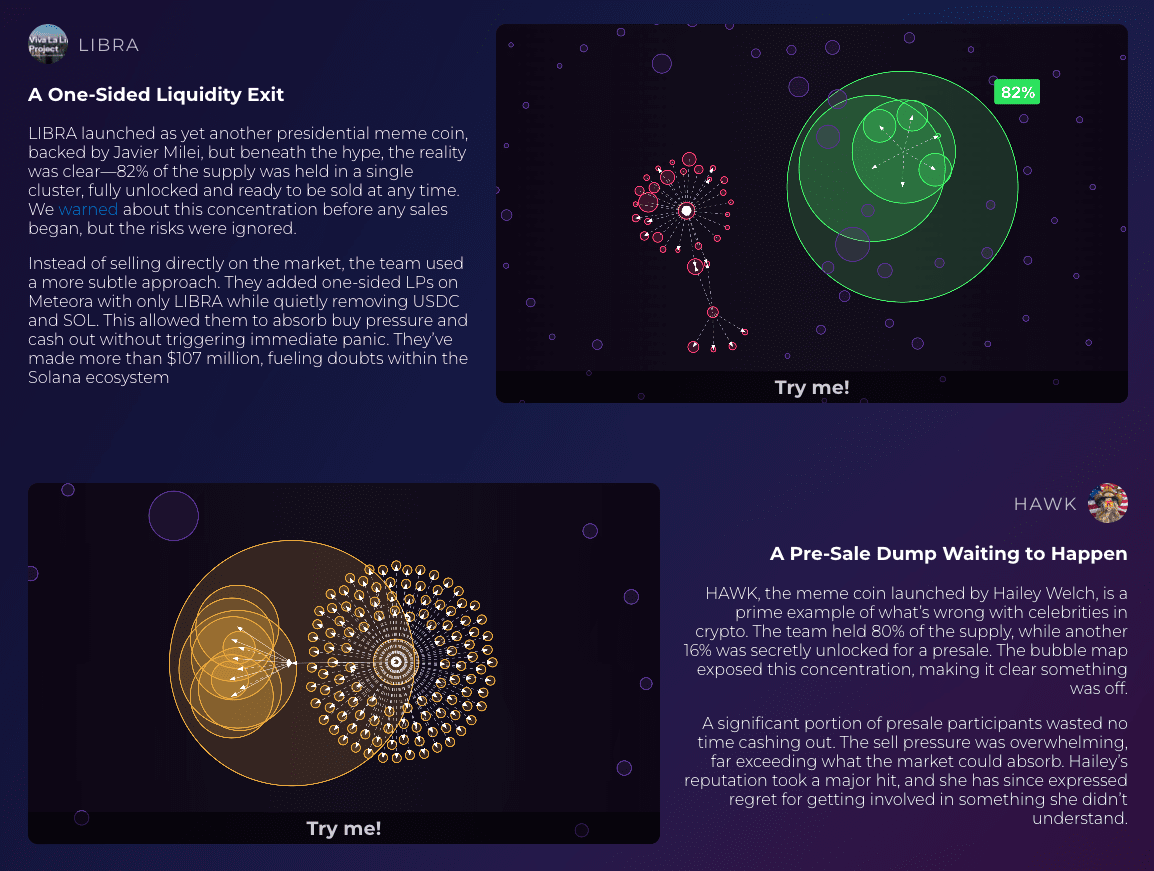
In the volatile Meme coin market filled with dramatic rises and falls, a sharp question always hangs over every trader: who is actually manipulating the token you bought? When a project claims to be 'completely decentralized', the on-chain data may be telling a different story—several associated wallets secretly control more than half of the chips, allowing the market maker to make the price plummet to zero with just a click of the mouse. This information asymmetry dilemma is being precisely dissected by Bubblemaps using data visualization as a scalpel.
Using bubble charts to penetrate the black box of the crypto world
Bubblemaps' core competitiveness lies in transforming obscure on-chain addresses into intuitive topological maps. While traditional tools still list wallet addresses in tables, its innovative bubble mapping technology can automatically cluster associated accounts, using different color blocks to label the holdings of insiders, market makers, and retail investors. An analysis case of a popular Meme coin in 2023 is quite convincing: the platform locked in 7 associated wallet groups in just 15 minutes, and these addresses, marked as 'high-risk clusters', were later confirmed to belong to the same development team, whose concentrated selling caused the token to drop 92% within a week.
This capability is essential in the current environment. According to data disclosed by the platform, among the TOP 100 Meme coins it scanned, 63% have at least 5 associated wallets controlling over 20% of the circulation, which ordinary investors cannot detect using just a blockchain explorer. More critically, Bubblemaps Intel Desk has built a community reconnaissance network through token incentives—when users submit evidence of suspicious wallet associations and it passes verification, they can receive $BMT rewards. This crowdsourcing model has labeled 17,000 high-risk address clusters, effectively installing an early warning system for the entire DeFi ecosystem.
The value capture logic of $BMT : from data tools to financial infrastructure
As an ecological governance token, the design of $BMT clearly transcends the simple functional token framework. Holders can not only use it to pay for advanced analytical services (such as cross-chain whale tracking) but, more importantly, participate in crucial platform decisions through staking. The governance vote in Q1 2024 showed that the community used 2.3 million $BMT to vote in favor of the proposal to 'add Base chain scanning'; this deep sense of participation has driven a 47% month-on-month increase in token staking.
From a financial model perspective, the scarcity of $BMT is deliberately reinforced: with a total supply of 100 million, 30% is reserved for community rewards, meaning that as the Intel Desk investigation tasks grow exponentially, circulation will continue to tighten. Notably, the platform recently reached data interface cooperation with three compliant exchanges, which will use $BMT to settle on-chain analysis API call fees. This development of B2B scenarios makes the token's value no longer solely reliant on retail trading demand.
When transparency becomes hard currency
During the trust reconstruction period following the FTX collapse, the market is voting for transparency with real money. The weekly active users of Bubblemaps have skyrocketed from 12,000 at the beginning of 2023 to 83,000 now, with 38% being professional traders managing over a million dollars in assets. A comment from a risk control director at a hedge fund is quite representative: 'We now require all holding projects to pass Bubblemaps' 'cleanliness test'; teams that refuse to disclose their token distribution maps are essentially rejecting the fundamental principles of modern finance.'
This trend is giving rise to new industry standards. Twelve Launchpad platforms have already made Bubblemaps audit reports a prerequisite for going live, while DEXs, including Uniswap, have begun exploring the integration of position concentration warning plugins. As regulatory scrutiny of the crypto market intensifies, the transparency infrastructure supported by $BMT is likely to become a key bargaining chip for project parties to comply—after all, rather than forcing disclosures through subpoenas by the SEC, it is better to proactively prove innocence with bubble charts.
From a more macro perspective, Bubblemaps is actually reconstructing the pricing factors of crypto assets. When the 'health of token distribution' can be quantified and compared like a PE ratio, the market will naturally punish teams that attempt to manipulate the chip game. This process of transparency may fundamentally change the survival rules of the industry—not relying on flashy white papers, but proving the real value of each token with on-chain data.

